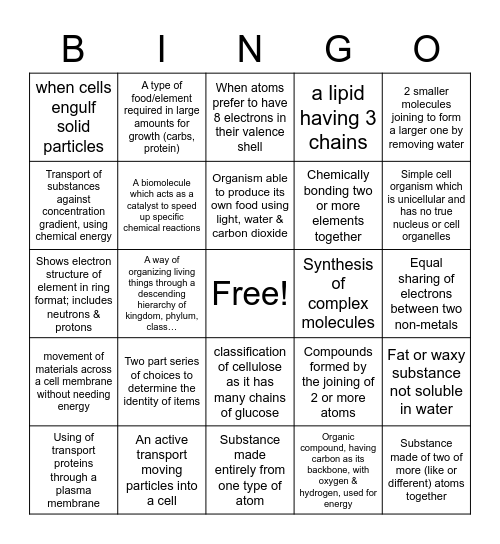

This bingo card has a free space and 54 words: process by which vesicle contents are released from the cell, movement of materials across a cell membrane without needing energy, process of using sunlight to convert low-energy compounds into high energy one, organisms that can't make their own food, classification of cellulose as it has many chains of glucose, the process of breaking down food to release energy completed by a cell, a lipid having 3 chains, Shows just electrons of the valence shell of the element, Transport of substances against concentration gradient, using chemical energy, random movement of molecules from a region of higher concentration, when cells engulf solid particles, movement of water across a membrane, An active transport moving particles into a cell, Using of transport proteins through a plasma membrane, Building blocks of proteins, Substance made entirely from one type of atom, Substance made of two of more (like or different) atoms together, Chemically bonding two or more elements together, Transfer of electrons between a metal and nonmetal, Equal sharing of electrons between two non-metals, Compounds formed by the joining of 2 or more atoms, Breakdown of complex molecules (lipids or proteins), Synthesis of complex molecules, 2 smaller molecules joining to form a larger one by removing water, Breaking of a large molecule into 2 smaller ones by adding water, A type of food/element required in large amounts for growth (carbs, protein), A small molecule, water, A type of food/element required in small amounts for growth (vitamins, minerals), Organic compound, having carbon as its backbone, with oxygen & hydrogen, used for energy, A generic term for saccharides (mono or di) – sweet tasting carbohydrate, Basic form of carbohydrate, simple sugar like glucose and fructose, Double sugar – 2 monosaccharides joined – sucrose, maltose, lactose, Macromolecule needed for essential amino acids, When atoms prefer to have 8 electrons in their valence shell, Molecules found in animal, vegetable fats and oils – has many hydrocarbon chains, Shows electron structure of element in ring format; includes neutrons & protons, Fat or waxy substance not soluble in water, Trigylceride (a type of lipid) usually solid at room temperature, A biomolecule which acts as a catalyst to speed up specific chemical reactions, When cells ingest fluid, the study of classifying animals, cells that contain a nucleus and organelles, and are enclosed by a membrane, Naming of an organism using 2 terms, the genus and species, Two part series of choices to determine the identity of items, The layer of the planet earth where life exists, Having similarities in internal or chromosomal structures (organs in similar places), Chemical compounds containing carbon, hydrogen, oxygen or nitrogen, Organism able to produce its own food using light, water & carbon dioxide, A way of organizing living things through a descending hierarchy of kingdom, phylum, class…, Simple cell organism which is unicellular and has no true nucleus or cell organelles, The study of living organisms, The field of biology that studies microscopic organisms. and Parasite that replicates only inside the living cells of an organism.
Science Lesson 5 | Cell Structures/Cell Transport | Cell BINGO! | Cell Transport Bingo | Quiz Study Guide
Share this URL with your players:
For more control of your online game, create a clone of this card first.
Learn how to conduct a bingo game.
With players vying for a you'll have to call about __ items before someone wins. There's a __% chance that a lucky player would win after calling __ items.
Tip: If you want your game to last longer (on average), add more unique words/images to it.